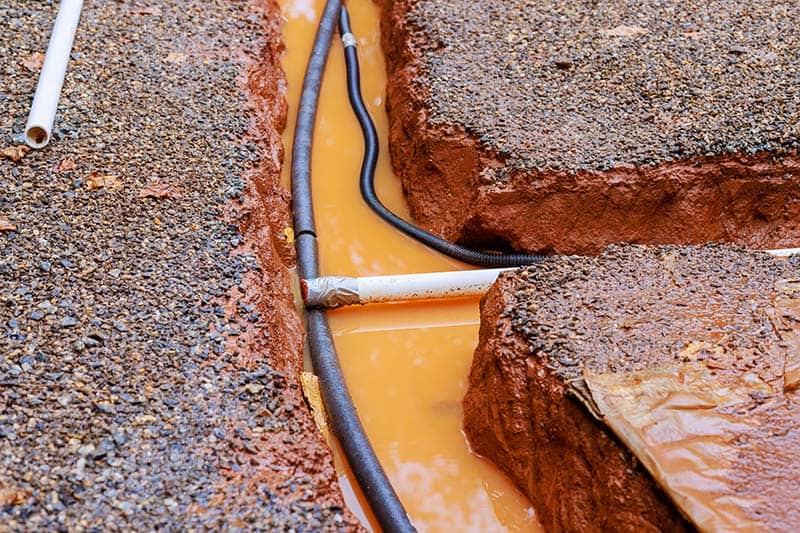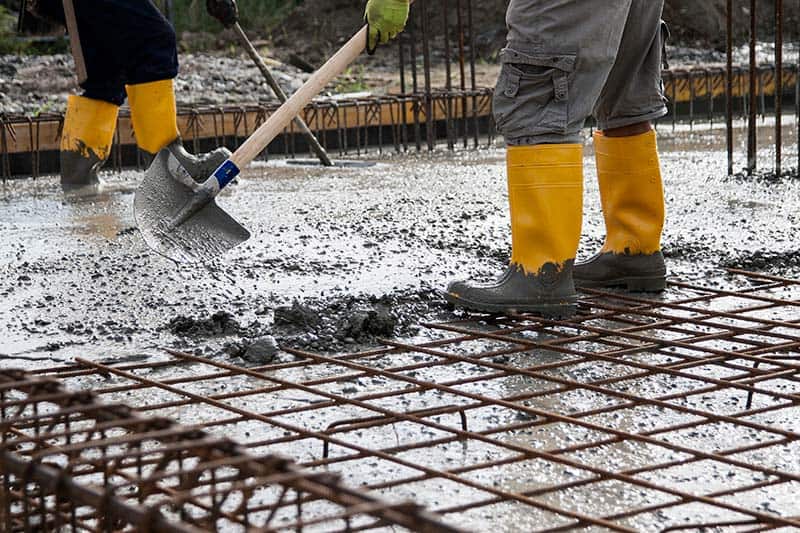What is a Slab Leak? Understanding This Hidden Threat to Your Home

Your home is where you build your life, create memories, and find comfort. Yet beneath the surface of many homes lies a potential threat that often goes unnoticed until significant damage has occurred. Slab leaks represent one of the most insidious plumbing problems homeowners can face, silently causing damage while remaining hidden from view.
Understanding what a slab leak is and recognizing its warning signs can save you thousands in repairs and protect your most valuable investment. Quality Plumbing is here to help you explore the causes of slab leaks, identify warning signs that may indicate their presence, discuss repair options, and provide strategies for prevention.
At Quality Plumbing, we’ve seen firsthand the devastation that undetected slab leaks can cause to homes and the financial burden they place on families. Our team of plumbing experts can detect and repair slab leaks with minimal disruption to your home and life. If you suspect you are dealing with what is a slab leak situation, contact us immediately at 816-472-4994 in Missouri or 913-894-4994 in Kansas.
What is a Slab Leak: Common Causes
Understanding what a slab leak is begins with knowing where and why they occur. Slab leaks develop in the water lines running below your home’s concrete foundation slab. These pipes, often made of copper, PEX, or, in older homes, galvanized steel, are vulnerable to several factors that can lead to failure over time, such as:
- Pipe Corrosion: If the soil surrounding your pipes has a high acid content or certain mineral compositions, it can accelerate the corrosion of metal pipes from the outside. Similarly, water quality issues, such as high chlorine levels of acidic water, can corrode pipes from within. Over time, this corrosion weakens the pipe walls, causing them to develop pinhole leaks or even complete ruptures.
- Abrasion: During normal thermal expansion and contraction cycles, pipes can rub against concrete, rebar, or other hard surfaces within the foundation, potentially causing damage. This constant friction gradually wears away the pipe material, eventually creating weak spots that develop into leaks.
- Shifting Soil or Foundation Settlement: As the soil beneath your home expands and contracts due to changes in moisture or natural settling, pipes can bend, twist, or become pinched. These forces place stress on pipe joints and connections, often leading to failures at these vulnerable points.
- Poor Installation: Pipes that were improperly secured, connected, or protected during construction may develop problems years later. Similarly, pipes that were damaged during the pouring of the concrete slab might function initially but fail prematurely as minor defects worsen over time.
The hidden nature of these pipes creates a significant challenge for homeowners. Unlike visible plumbing in your walls or under sinks, pipes beneath the concrete foundation remain out of sight, making early detection difficult without specialized equipment. This invisibility factor is what makes understanding what a slab leak is so crucial—you need to recognize the warning signs since you can’t visually inspect the pipes themselves.
What is a Slab Leak: The Warning Signs

Ignoring the signs of a slab leak can lead to devastating consequences for your home. The dangers extend far beyond a simple water leak, potentially causing structural damage to your home’s foundation, mold and mildew growth, higher utility bills, flooding, water damage, and a reduced property value.
Recognizing the warning signs of a slab leak early can help you avoid these serious consequences. Here are the key indicators to watch for:
- Unexplained increase in water bills: If your water usage seems normal but your bill has increased significantly, a hidden leak may be the culprit.
- Sound of running water when no fixtures are in use: Turn off all water-using appliances and fixtures in your home, then listen carefully. If you can hear water running within your walls or floor, you may have a slab leak.
- Warm spots on your floor: This is particularly common with hot water line leaks. Remove your shoes and walk slowly across your floors, especially in bathrooms, kitchens, or near water heaters. Unusual warm spots may indicate hot water escaping beneath the slab.
- Damp or wet flooring with no apparent source: Water will eventually find its way to the surface. Moist carpeting, warped hardwood, or damp tile without an apparent cause could indicate water seeping up through your foundation.
- Decreased water pressure throughout your home: When water escapes from your plumbing system before reaching your fixtures, you may notice reduced pressure at faucets and showerheads throughout your home.
- Mold or mildew growth under carpets or along baseboards: These fungi thrive in the damp conditions created by slab leaks. Their presence, especially in areas that shouldn’t be wet, can be a telltale sign.
- Foundation cracks or shifting: As water erodes the soil beneath your foundation, the concrete may crack, move, or settle unevenly. New cracks in your walls, especially near doors and windows or doors that suddenly stick or won’t close properly, can indicate foundation movement.
Knowing these warning signs of a slab leak is crucial before we discuss repair options. Early detection not only minimizes damage but also expands your repair choices, potentially saving you thousands of dollars and preventing extensive disruption to your home and daily life.
[Related: Why is My Water Bill So High? Understanding and Addressing Unexpected Increases]
What is a Slab Leak: Repair Options
Once a slab leak has been properly located, you need to proceed with repairing the leak. Several options are available, each with advantages and considerations, such as:
- Spot repair: This method involves accessing the specific leak location by breaking through the concrete slab directly above the damaged pipe location. Spot repair is most appropriate when the leak is isolated to a single, easily accessible area and the rest of the plumbing system remains in good condition.
- Re-routing: Creates new pipe paths that bypass the slab entirely, typically running pipes through attics, walls, or ceilings instead of beneath the foundation. This approach avoids the need for extensive concrete demolition and provides easier access for any future repairs.
- Re-piping: Involves the complete replacement of all affected plumbing lines throughout the home. This comprehensive approach addresses not just the current leak but prevents future problems by replacing aging or vulnerable pipes before they fail.
- Epoxy pipe coating: Offers an innovative solution that restores pipes from the inside without requiring extensive demolition. This process involves cleaning the interior of existing pipes and then coating them with an epoxy resin that seals leaks and prevents future corrosion.
Determining the best slab leak repair options for your specific situation requires a professional evaluation. At Quality Plumbing, our experts thoroughly assess your entire plumbing system before recommending a repair strategy. We consider not just the immediate fix but the long-term health of your plumbing and the protection of your home.
What is a Slab Leak: Prevention Strategies

While understanding what is a slab leak and how to repair it is important, preventing these costly problems in the first place is even better. Implementing preventive measures can significantly reduce your risk of experiencing slab leaks and protect your home from associated damage. The best slab leak prevention strategies include:
- Regular plumbing inspections and maintenance: Having a qualified plumber inspect your home’s plumbing system annually can identify potential issues before they develop into leaks. These professionals can identify early signs of pipe corrosion, verify proper pipe support, and evaluate the overall system health.
- Water pressure regulation: Excessive water pressure places undue stress on your pipes, accelerating wear and potentially causing failures at weak points. The ideal water pressure for residential plumbing typically ranges between 40 and 60 psi (pounds per square inch). If your home’s water pressure exceeds this range, installing a pressure regulator can protect your entire plumbing system, not just the pipes under your slab.
- Water quality testing and treatment: Highly acidic or mineral-laden water can corrode pipes from the inside out, eventually leading to leaks. Having your water tested can help identify potential issues, while water treatment systems, such as water softeners or neutralizers, can mitigate these problems.
- Proper foundation drainage: Ensuring that gutters, downspouts, and landscape grading direct water away from your foundation helps maintain a more consistent moisture level in the soil beneath your home. This consistency reduces the expansion and contraction cycles that can place stress on your plumbing.
- Awareness of warning signs: The sooner you recognize what a slab leak is, the less damage it’ll cause and the more repair options you’ll have available. Monitoring your water bills for unexplained increases, being attentive to changes in water pressure, and occasionally checking your floors for warm spots or dampness can help you catch problems early.
Preventive strategies represent the most cost-effective approach to plumbing care. You won’t even have to search or ask, “What is a slab leak?” anymore when you implement these prevention methods.
[Related: Plumbing Emergency Tips: What You Need to Know]
What is a Slab Leak: When to Call the Professionals
The moment you suspect you might be dealing with what is a slab leak, contacting a professional plumber should be your top priority. Early intervention not only minimizes damage to your home but often results in less extensive and less expensive repairs.
While DIY approaches work well for many household projects, slab leak detection and repair present unique challenges that make professional involvement necessary. The risks of DIY repairs in this context are substantial. Without specialized equipment, accurately locating the leak is nearly impossible, potentially leading to unnecessary concrete demolition as you search for the source of the leak.
Contact Quality Plumbing to Repair Your Slab Leak
Understanding what a slab leak is represents only the first step in protecting your home from this hidden threat. If you suspect you may have a slab leak or want to schedule a preventive inspection, contact the experts at Quality Plumbing for the experience and specialized equipment to detect and repair slab leaks efficiently, protecting your home and peace of mind.
Quality Plumbing is here to exceed your expectations every time. If you’re in Missouri, call 816-472-4994, and if you’re in Kansas, call 913-894-4994 to discover why we’re the trusted choice for all your plumbing needs.

